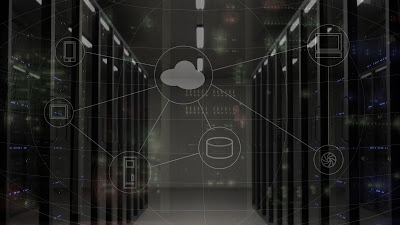what is Cloud Computing?
Cloud computing
 |
| techeeINDIA |
Cloud computing is internet-based
computing, whereby shared resources, software, and information are provided to
computers and other devices on demand, like the electricity grid. A basic
definition of cloud computing is the use of the internet for the tasks you
perform on your computer for storage, retrieval and access. The “cloud”
represent the internet. Cloud computing is a new name for an old concept: the delivery of computing services from a
remote location. cloud computing services are delivered through a network,
usually the internet.
Characteristics: -
cloud computing has five essential
characteristics: -
1) On demand
self-services:
- Users
are able to provision, monitor and manage computing resources as needed without
the help of human administrators.
2) Broad
network access:
- Computing
services are delivered over standard networks and heterogeneous devices.
3) Rapid
elasticity:
- IT resources are able
to scale out and in quickly and on as needed basis.
4) Resource
pooling: - IT resources are shared
across multiple applications and tenants in a non-dedicated manner.
5) Measured
services:
- IT resource utilization
is tracked for each application and tenant, typically for public cloud billing
or private cloud chargeback.
 |
| techeeINDIA |
Layers
of cloud computing system: -
The cloud computing system has mainly
these layers: Client, Application, Platform, and infrastructure. (Additionally,
server is also sometimes considered as layer as the server makes available
hardware and software products that are specially designed for the delivery of
cloud services.)
Let us talk about these four layers one
by one:
a) Client: - The client consists of hardware and
software that access cloud services. The client can be a thick client or a thin
client. A thick client refers to a fully functionality needed to accomplish
the necessary tasks. Examples of thin clients include new age smartphones,
tablets etc.
b) Application
layer or Software as a service (SaaS):
- In this layer, a
complete application is offered to the customer, as a service on demand. A single
instant of the service runs on the cloud & multiple end users are serviced.
On the customer's side, there is no need for upfront investment in servers or
software licenses, while for the provider, the costs are lowered, since only a
single application needs to be hosted and maintained. Today SaaS is offered by
companies such as Google, Salesforce, Microsoft, zoho, etc.
c) Platform as
a service (Paas):
- Here, a layer of
software, or development environment is encapsulated & offered as a
service, upon which other higher levels of service can be built. The customer
has the freedom to build his own applications, which run on the providers
infrastructure. To meet manageability and scalability requirements of the
applications, PaaS providers offer a predefined combination of OS and
application servers, such as LAMP platform (Linux, Apache, MySQL and PHP),
restricted J2EE, Ruby etc. Googles App Engine, Force.com, etc. are some of the
popular PaaS examples.
d) Infrastructure
as a service (IaaS):
-IaaS provides basic
storage and computing capabilities as standardized services over the networks.
Servers, storage system, networking equipment, data Centre space etc. are
pooled and made available to handle workloads. The customer would typically
deploy his own software on the infrastructure. Some common examples are Amazon,
GoGrid, 3 tera, etc.
Deployments
models:
-
 |
| techeeINDIA |
There are different types of clouds that
you can subscribe to depending on your needs. As a home user or small business
owner, you will most likely use public cloud services. Enterprises can choose
to deploy applicants on Public, Private or Hybrid clouds.
Four deployment models of clouds are: -
1. Private clouds: -
These are the clouds
for exclusive use by a single organization and typically controlled, managed
and hosted in private data centers. The hosting and operation of private clouds
may also be outsourced to a third-party service provider, but a private cloud
remains for the exclusive use of one organization.
2. Public clouds: -
These are the clouds
for use by multiple organizations (tenants) on a shared basis and hosted and
managed by a third-party service provider.
3. Community clouds: -
These are the clouds
for use by a group of related organizations who wish to make use of a common
cloud computing environment. For example, a community might consist of the
different branches of the military, all the universities in a given region, or
all the suppliers to a large manufacturer.
4. Hybrid clouds: -
When a single
organization adopts both private and public clouds for a single application in
order to take advantage of the benefits of both. For example. In a cloud
bursting scenario, an organization might run the steady-state workload of an
application on a private cloud, but when a spike in workload occurs, such as at
the end of the financial quarter or during the holiday season, they can burst
out to use computing capacity from a public cloud, then return those resources
to the public pool when they are no longer needed.
-Jai Hind
what is cloud computing?
i.
what is cloud computing?
 Reviewed by mushrafkhan772
on
June 29, 2018
Rating:
Reviewed by mushrafkhan772
on
June 29, 2018
Rating:
 Reviewed by mushrafkhan772
on
June 29, 2018
Rating:
Reviewed by mushrafkhan772
on
June 29, 2018
Rating:









Really it's a technological information.
ReplyDeletethank you so much bhai
DeleteUseful knowledge
ReplyDeletebro
thank you bro.
DeleteNice post
ReplyDeleteFor more best tech video visit
https://www.youtube.com/channel/UCR0mOQlA2mvQxGdbM3wc1Ig
thank you bro
DeleteNice work
ReplyDeletethank you vishwajeet bro
ReplyDeletethank you jon
ReplyDeletethank you narayana p
ReplyDelete